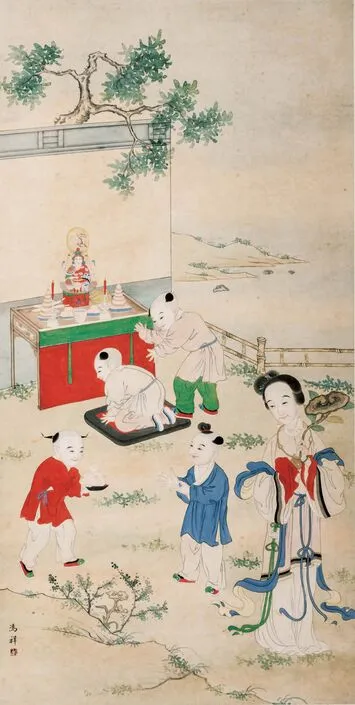一个时代两座城池文化的个性与共性
文本刊记者 陈思静

分染麻质水边风景鹤纹单衣 东京都江户东京博物馆藏The blue-nose cloud-grained cranes costume Edo-Tokyo Museum
作为“中日韩国际博物馆学术研讨会”的重要成果之一, 8月14日至10月7日,由北京首都博物馆和东京都江户东京博物馆主办的“都市·生活——18世纪的东京与北京”展在首都博物馆举行。展览的创意是在“中日韩国际博物馆学术研讨会”的合作模式下提出的,由两馆策展人员共同策划完成。
展览以18世纪的北京与东京为背景,通过两个国家城市博物馆所藏精品文物,从宏观城市功能与规划,到百姓的城市生活,再到丰富多彩的城市艺术,多视角、多维度地展示了清前期盛极一时的北京和幕府时期繁花似锦的江户。2017年,展览在东京率先拉开帷幕,今年8月14日移师北京。
“2017年展览在东京展出时,首都博物馆展品占2/3;此次北京展出,东京都江户东京博物馆展品占2/3。 ”首都博物馆党委书记白杰介绍,此次展览共展出展品181件(套) ,其中日方展品112件(套) 。展览通过图片资料、生活民俗资料、工艺品等各类型展品,展示了18世纪北京与东京的城市面貌、城市生活以及东京的各类艺术发展,向观众介绍了两座城市的构造、生活以及文化,并探究两者的异同。一个时代、两座城池,物质生活所呈现的异与同,折射出两个国家文化的个性与共性。

《康熙六旬万寿图》印版(局部) 首都博物馆藏Kangxi 60-year-old Longevity Print (Partial) Beijing Capital Museum
18世纪的东京处于江户幕府的管制之下,18世纪的北京处于康乾盛世时期,两地政治安定,生活富足,尽显东方文化的城市共性。北京首都博物馆和东京都江户东京博物馆作为各自首都的城市博物馆代表,共同研究城市发展历史对人们生活的影响,把策划重点放在展现中日同一时期历史文化和人民生活的看点上,发挥城市博物馆展览的特性。因此,展览分“城市营造”“城市生活”“城市艺蕴”三个部分,对18世纪的东京与北京两个城市的发展史、生活和文化进行了全方位的比较。
“之所以采取对比的形式,是因为我们了解知识结构都是从已知到未知,希望观众能从自己所在城市的生活迁移到同一时期另外一个城市,去了解他们的生活。 ”展览中方策展人张靓说。尤其是“城市生活”部分,从居住、服饰、经商、节日、育儿、教育、娱乐7个部分,对比展示了双城历史片段。
并列放置的《康熙六旬万寿图》印版、日本的《熙代胜览》两幅长卷拉开了“城市生活”的帷幕;一旁来自清朝的一品文官夏季官服青色纳纱云鹤纹补单褂与江户城镇女性所穿和服分染麻质水边风景鹤纹单衣相对应; 《近代职业大全(浮世绘版)》描绘了烟袋店、烟草店,还有路过店铺门前的耍猴人等,这些形象可以和《老北京三百六十行画册》里相应的图像进行对比。展期横跨七夕和中秋节,因此在节日部分,展览着重比较了两国关于七夕和中秋的习俗,在一轮明月两侧分别摆放了中日两国的中秋赏月图。如此,观众可以更直观更深入地对比同一历史节点、同一场景下两座城市的特点和风情、共性与特性,从而深化对自身世界与外部世界的认知。
“同样是过中秋节,但是两国在节日习俗当中还是有一定的差异。比如,中国的八月十五是中秋节,中国在这一天会赏月吃月饼,而日本赏月是在八月十五日和九月十三日这两天,而且他们吃的是小点心、小年糕;还有七夕节,中国有乞巧的习俗,是女性进行织绣比赛之类的活动,但是日本会把祝福语和吉祥祈愿的心愿写在彩纸上,拴在小竹竿上。 ”张靓介绍。
此外,在展览上还能看到来自日本的算盘、围棋,以及取自中国传说及神话人物造型的印盒等物品。东京都江户东京博物馆馆长藤森照信表示,日本和中国拥有悠久的文化交流历史,即便在江户时代日本已经开始闭关锁国,文化交流也未曾停滞过。张靓认为:“两座城市的共性有一部分正是中日文化的相互影响。中日两国作为邻国来说,交往的历史非常悠久,文化方面的相互影响是一直以来都有的。这也是我们做这个展览希望传达给观众的内容。”

中秋拜月图 首都博物馆藏Moon Appreciation in Mid-Autumn Festival Beijing Capital Museum
As one of the important achievements of the "China,Japan and South Korea International Museum Symposium", "City·Life - Tokyo and Beijing in the 18thCentury" hosted by the Beijing Capital Museum and Edo-Tokyo Museum has been held at the Beijing Capital Museum from August 14thto October 7th. The creativity of the exhibition, proposed under the cooperation mode of the "China, Japan and South Korea International Museum Symposium" has been jointly planned by the curators of the two museums.
Based on Beijing and Tokyo in the 18thcentury, as the backgrand the exhibition, through the collection of fine cultural relics from two national urban museums and macroscopic urban functions and planning, to urban life of the people and colorful urban art, displays the splendid early Qing Dynasty and fascinating Edo during the Shogun period via the multi-perspective and multi-dimensional aspects.It took the lead in Tokyo in 2017, and moved to Beijing on August 14th, this year.
"When the 2017 exhibition was held in Tokyo, exhibits from the Beijing Capital Museum accounted for 2 / 3 of the totals; this time in Beijing, those of the Edo Tokyo Museum of Tokyo accounted for 2 / 3," Said BAI Jie, secretary of the Party Committee of the Capital Museum. The event has introduced 181 pieces (sets) of exhibits in total, including 112 pieces (sets) from Japan. Through various types of exhibits,such as picture materials, folklore materials and handicrafts,the exhibition shows the urban appearance, urban life and various artistic developments of Beijing and Tokyo in the 18thcentury, introducing the structure, life and culture of the two cities to the audiences, and exploring the bilateral similarities and differences. An era and two cities, the differences and similarities of material life reflect the individuality and commonality of the cultures of the two countries.
In the 18thcentury, Tokyo was under the control of the Edo Shogun, and Beijing was in its prosperous period of emperors of Kangxi and Qianlong. The two places were politically stable and rich in life, showcasing the urban commonality of oriental culture. The Beijing Capital Museum and the Edo Tokyo Museum in Tokyo, as representatives of the city museums in their respective capitals, jointly study the impact of urban development history on people's lives, and focus on the display of historical culture and people's lives in the same period of China and Japan, playing the characteristic roles of the city museum exhibition. Therefore, the exhibition is divided into three parts: urban construction, urban life and urban art, comparing the history, life and culture of the 18thcentury Tokyo and Beijing cities in all aspects.
"The reason for the contrast mode is because we understand the knowledge structure through known to unknown. I hope that the audiences can move from the life of their own city to another city in the same period so as to understand their lives." ZHANG Liang, the curator of the exhibition from Chinese side, made the comment, especially in the "urban life" part, from the seven parts as residence, clothing,business, festivals, parenting, education and entertainment,the exhibition shows and compares the historical fragments of the twin cities.
The two long scrolls of theKangxi 60-year-old Longevity Printand the Kidai shoran (Depicting the Prosperity of the Nihonbashi distict) from Japan side-by-side have opened the curtain of"urban life"; the blue-nose cloud-grained cranes, the summer working costume of first degree civilian officials of the Qing Dynasty and the quilts with linen-like waterside scenery design clothing of the Edo urban women echoed each other; theModern Occupational Encyclopedia (Ukiyo-e Edition)depicted a tobacco-bag store, a tobacco shop, and a monkey-training entertainer and others who passed by the front of the store,these images can be compared with the corresponding images in theOld Beijing 360-Job Catalogue. The exhibition spans the Double Seventh Festival and the Mid-Autumn Festival. Therefore,the exhibition focused on comparing the customs of the two countries on the Double Seventh and Mid-Autumn Festival in the festival section. On the two sides of a bright moon, it lays the pictures of admiring moon of China and Japan. In this way,the audiences can more intuitively and deeply compare the characteristics and styles, commonalities and features of the same historical node and the two cities in the same scene, thus deepening the perception of their own and the external world."Spending the Mid-Autumn Festival in two countries alike,but there are still some differences in festival customs. For example, China's August 15this the Mid-Autumn Festival according to its lunar calendar, and Chinese will enjoy moon cakes on this day, while Japan's moon appreciation is on August 15thand September 13th, and they will eat small snacks and rice cakes; for the Double Seventh Festival, China has a wellbehaved custom, an activity for women to engage in weaving and embroidery competitions. However, Japan will write the wishes of blessings and auspicious wishes on colored paper and lie on the bamboo poles" said by ZHANG Liang.
In addition, the exhibition also included the abacus and Go game, and printed boxes from Chinese legends and mythical figures. Terunobu Fujimori, curator of Edo-Tokyo Museum said that Japan and China have a long history of cultural exchanges. Even in the Edo period, Japan has begun to close its doors, but cultural exchanges never stopped. ZHANG Liang believed that Part of the commonality of the two cities is the mutual influence of the two-sided culture. As the neighboring country, the two countries possess a very long history of exchanges, and cultural interactions have always existed. This is also what we want to convey to the audiences via this exhibition.

《近代职业大全》中卷(局部) 东京都江户东京博物馆藏Modern Occupational Encyclopeclia middle volume (Partial) Edo-Tokyo Museum

青色纳纱云鹤纹补单褂 首都博物馆藏Quilts with linen-like waterside scenery design clothing Beijing Capital Museum

